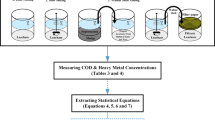Abstract
A study was carried out in a specially designed settling column to investigate the settling characteristics of effluents arising from Karachi tanneries. The Jar-tests were conducted to determine the optimum dosage of coagulants such as potash alum and ferric chloride to maximize the removal of suspended solids (S.S) from the wastes. For alumn, the optimum dosage was found to be 150 mg L−1, whereas with ferric chloride it was 30 mg L−1. Experiments carried out in the settling column with the optimum coagulant dosages showed that the coagulation with ferric chloride was much better than with alumn, as it removes about 84% S.S from the wastes compared to 70% removal obtained in case of alumn. Design curves in terms of percent removal of S.S. vs loading rate and detention time were constructed using data obtained from settling column. These curves can be used in designing the settling tanks employed in the tannery wastes treatment plants.
Similar content being viewed by others
References
Beg, M. A. A., Mahmood, N. and Naeem, S.: 1990,J. Sci. Ind. Res. 33(10), 431.
Clonfero, G.: 1987, Latin American Seminar on Treatment of Tannery Wastes, UNIDO, Port Alegre, 16–20 November.
Dreiss, Shirley J.: 1986,Ground Water 24, 3.
Eckenfelder, N. W. Jr.: 1989,Industrial Water Pollution Control (International Edition), McGraw-Hill, Singapore, p. 58.
Fales, A. L.: 1929,Ind. Eng. Chem. 21, 216.
Faust, S. D., Osman, M. Aly: 1983,Chemistry of Water Treatment, Butterworths Publishers, pp. 277–360.
Iqbal, M., Qureshi, A. W. and Rizvi, N.: 1993,Pak. J. Sci. Res. 36(2–3), 114.
Meynell, P. J. and Tharwani, R.: 1992, Paper presented in IUCN workshop, May 12–13, 1992, Pakistan Tanners Association (P.T.A.), Project Document on combined Effluent Treatment plant for Karachi Tanneries.
Qureshi, A. W., Rizvi, N. and Iqbal, M.: 1989,Pak. J. Sci. Ind. Res. 32(12), 795.
Peavy, H. S., Rowe, D. R. and Techobanglous, G.: 1987,Environmental Engineering (International Edition), McGraw-Hill, Siganpre, p. 120.
Rauf, M.: 1994, Investigation and Analysis of Settling Characteristics of Karachi Tannery Waste Water, M.Sc. Thesis, Institute of Environmental Engineering and Research, NED University of Engineering and Technology, Karachi, Pakistan.
Sarber, R. W.: 1941,J. Am. Leather Chem. Assos 36, 463.
Shastry, C. A.: 1984, Paper presented in the 19th Tanners Get-Together, Madras, India.
Sutherland, R.: 1947,Ind. Eng. Chem. 39(5), 630.
Author information
Authors and Affiliations
Additional information
Supervisor of the project, correspondence to be addressed.
Post Graduate Student, presently employed as research Engineer in PCSIR Laboratories, Karachi.
Rights and permissions
About this article
Cite this article
Akhtar, W., Rauf, M., Ali, I. et al. Optimum design of sedimentation tanks based on setting characteristics of Karachi tannery wastes. Water Air Soil Pollut 98, 199–211 (1997). https://doi.org/10.1007/BF02047034
Received:
Accepted:
Issue Date:
DOI: https://doi.org/10.1007/BF02047034




